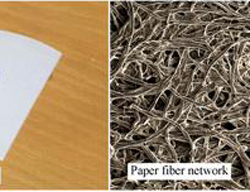Understanding the way liquid spreads through paper

Investigators documented spreading of ink on a filter paper of Whatman Grade 1, and analyzed the process with a scanning electron microscope. Scanning micrographic results show paper fiber distribution, along with the micro-particle-image-velocimetry measure of random liquid movement through the network. Researchers conclude this evidence confirms diffusive dynamics at work in the spread of liquid through a paper matrix. Credit: Suman Chakrabort
Molecules move randomly, colliding with each other in continual motion. You can even smell this process at times; it's how perfume spreads across a room when the air is still. The process is termed diffusion and the theory of diffusion can be applied to liquid spreading through paper, too – a process at work in a range of everyday products, from ink pens to paper sampling patches for medical tests.
Now, a team of researchers in India have developed a model that deepens their conceptual grasp of how liquids spread through paper.
“Liquid spreading in a paper is essentially random liquid motion through a randomly distributed network of fibers,” said Suman Chakraborty, lead researcher of the investigation at the Indian Institute of Technology Kharagpur, and the Advancement Technology Development Centre, both located in Kharagpur, India. Results are published this week in Applied Physics Letters, from AIP Publishing.
Diffusion is a well-known process. But the team's elaboration of diffusion theory in the context of paper-liquid interactions, which pose tortuous fiber networks to transport dynamics, is novel and reveals new theoretical detail. In their experiment, the researchers observed ink spreading on filter paper using a scanning electron microscope.
The team mapped liquid spreading dynamics from a single fiber capillary to a larger network of the fibers. They then computed the resulting transport characteristics, with results confirming a generalized unified perspective of diffusion at work in the process of liquid moving through a paper matrix. Scanning micrographic images show paper fiber distributions, along with the micro-particle-image-velocimetry measure of random liquid movement through the network.
“Our study reveals that, despite such diversified uses of paper interacting with liquids, there is a fundamental uniqueness of liquid spreading through paper leading toward a general and unified theory about it,” Chakraborty said.
The theory holds that molecules of a liquid move through the fiber network of paper following the principles of universal diffusive dynamics. “Paper is constituted of a network of fibers distributed randomly,” said Chakraborty. “As a consequence, random motion of the liquid in all possible directions occurs. We know molecules move randomly and collide with each other, and this is the premise of diffusion.”
Despite wide use of liquid-infused paper technologies, there are gaps in the understanding of the basic science behind its behavior. Chakraborty and his students, Kaustav Chaudhury and Shantimoy Kar, help fill that gap.
By understanding liquid spread in the paradigm of diffusion, scientists can control it more precisely to create and refine new products that involve liquid spreading through paper. For example, current markets have validated an important potential property of paper: acting as the essential building block of a rapid diagnostic kit in an ultra-low-cost paradigm.
Examples of this application include pregnancy test strips; alkalinity or acidity tests of beauty and baby soaps using a paper strip; paper-strips for checking water quality; and medical diagnosis aided by paper-strip tests of urine, saliva and blood. The author's diffusion model of liquid spreading in paper can also improve papers and inks used for writing, drawing and painting.
Next, the investigators plan to develop smart and compact technologies for diagnostic purposes, advancing the existing paper based platforms.
“The key objectives are to obtain rapid results at the expense of low costs. To this end, the paper shows a promising prospect of being a tool to serve both the objectives. The present work, as we believe, will pave the way for the design and development of the paper-based technologies to serve a wider public,” Chakraborty said.
###
The article, “Diffusive dynamics on paper matrix,” is authored by Kaustav Chaudhury, Shantimoy Kar and Suman Chakraborty. The article will appear in the journal Applied Physics Letters on November 29, 2016 (DOI: 10.1063/1.4966992). After that date, it can be accessed at: http://scitation.
About the journal:
Applied Physics Letters features concise, rapid reports on significant new findings in applied physics. The journal covers new experimental and theoretical research on applications of physics phenomena related to all branches of science, engineering, and modern technology.
Media Contact
All latest news from the category: Physics and Astronomy
This area deals with the fundamental laws and building blocks of nature and how they interact, the properties and the behavior of matter, and research into space and time and their structures.
innovations-report provides in-depth reports and articles on subjects such as astrophysics, laser technologies, nuclear, quantum, particle and solid-state physics, nanotechnologies, planetary research and findings (Mars, Venus) and developments related to the Hubble Telescope.
Newest articles

Innovative vortex beam technology
…unleashes ultra-secure, high-capacity data transmission. Scientists have developed a breakthrough optical technology that could dramatically enhance the capacity and security of data transmission (Fig. 1). By utilizing a new type…

Tiny dancers: Scientists synchronise bacterial motion
Researchers at TU Delft have discovered that E. coli bacteria can synchronise their movements, creating order in seemingly random biological systems. By trapping individual bacteria in micro-engineered circular cavities and…

Primary investigation on ram-rotor detonation engine
Detonation is a supersonic combustion wave, characterized by a shock wave driven by the energy release from closely coupled chemical reactions. It is a typical form of pressure gain combustion,…



